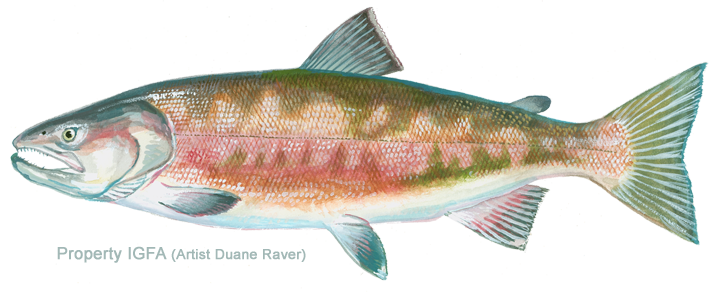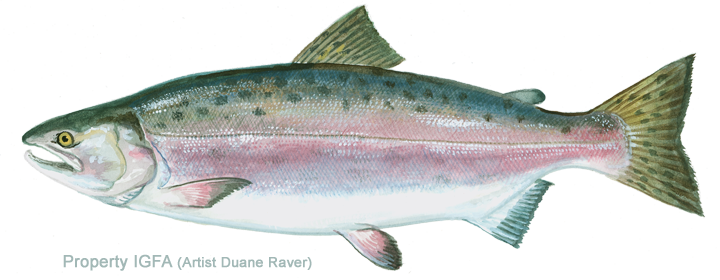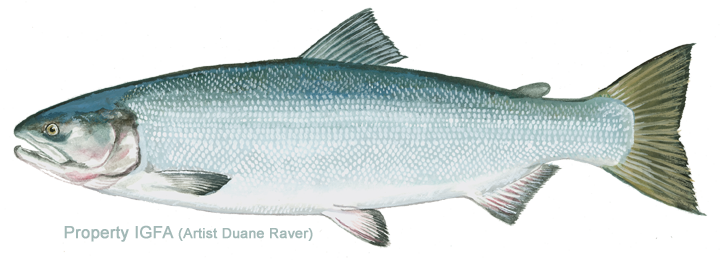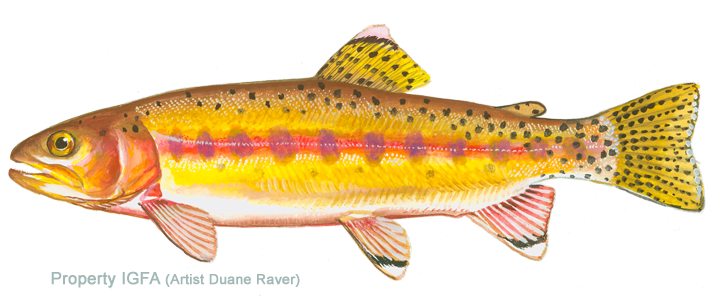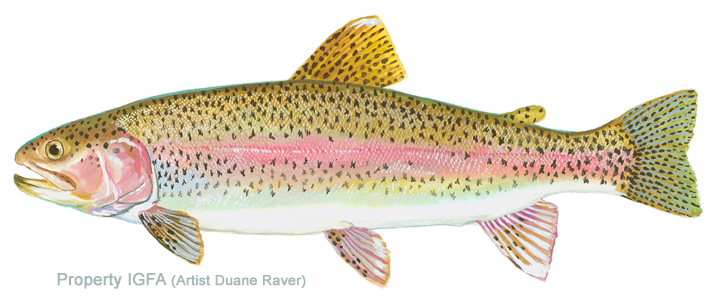Game Fish Identification Reference Guides
Salmon, Chinook
(Oncorhynchus tshawytscha)
(Oncorhynchus tshawytscha)

(Walbaum, 1792); SALMONIDAE FAMILY; also called king salmon, spring salmon, tyee, quinnat, blackmouth
It is a member of the Pacific salmon genus Oncorhynchus and is both largest and least abundant of this group. It is endemic to the Pacific and rarely, the Arctic Ocean as well as the Bering Sea, the Okhotsk Sea, the Sea of Japan, and most of the rivers that flow into these waters; from Hokkaido in northern Japan to the Anadyr River in the former U.S.S.R., and from the Ventura River in southern California to Point Hope, Alaska. Since as early as 1872, it has been introduced into other waters around the world including the Great Lakes, Atlantic and Gulf states of the U.S., some areas of Central and South America, Europe, and the South Pacific. These transplanted populations apparently failed due to an inability to maintain spawning levels, with the exceptions of South Island in New Zealand, and to some degree in the Great Lakes. In Chile more recent transplants have shown hope of becoming established with some chinook returning to spawn.
Its body is typical of the Pacific salmon group (see “Salmons, Trouts, and Chars”). At sea, it is basically a silvery fish with spotting on the back, upper sides, top of the head, and all the fins, including all of the tail fin. Spawning chinooks are olive brown to purplish or even red and undergo a radical metamorphosis, especially the males which develop a large kype. One way to distinguish the chinook from other species is by its black mouth and gums. The similar looking coho, Oncorhynchus kisutch, has a black mouth, but white gums, except in the Great Lakes population where the gums may be gray or black.
It is the largest salmonid in North America, growing to at least 5 ft (1.52 m) and 126 lb (57 kg). It is an extremely important food and commercial fish, and due to its large size and game nature, an important sport fish. It is the only Pacific salmon in which the meat may be regularly either red or white, but the red meat commands a higher price
It is a member of the Pacific salmon genus Oncorhynchus and is both largest and least abundant of this group. It is endemic to the Pacific and rarely, the Arctic Ocean as well as the Bering Sea, the Okhotsk Sea, the Sea of Japan, and most of the rivers that flow into these waters; from Hokkaido in northern Japan to the Anadyr River in the former U.S.S.R., and from the Ventura River in southern California to Point Hope, Alaska. Since as early as 1872, it has been introduced into other waters around the world including the Great Lakes, Atlantic and Gulf states of the U.S., some areas of Central and South America, Europe, and the South Pacific. These transplanted populations apparently failed due to an inability to maintain spawning levels, with the exceptions of South Island in New Zealand, and to some degree in the Great Lakes. In Chile more recent transplants have shown hope of becoming established with some chinook returning to spawn.
Its body is typical of the Pacific salmon group (see “Salmons, Trouts, and Chars”). At sea, it is basically a silvery fish with spotting on the back, upper sides, top of the head, and all the fins, including all of the tail fin. Spawning chinooks are olive brown to purplish or even red and undergo a radical metamorphosis, especially the males which develop a large kype. One way to distinguish the chinook from other species is by its black mouth and gums. The similar looking coho, Oncorhynchus kisutch, has a black mouth, but white gums, except in the Great Lakes population where the gums may be gray or black.
It is the largest salmonid in North America, growing to at least 5 ft (1.52 m) and 126 lb (57 kg). It is an extremely important food and commercial fish, and due to its large size and game nature, an important sport fish. It is the only Pacific salmon in which the meat may be regularly either red or white, but the red meat commands a higher price














